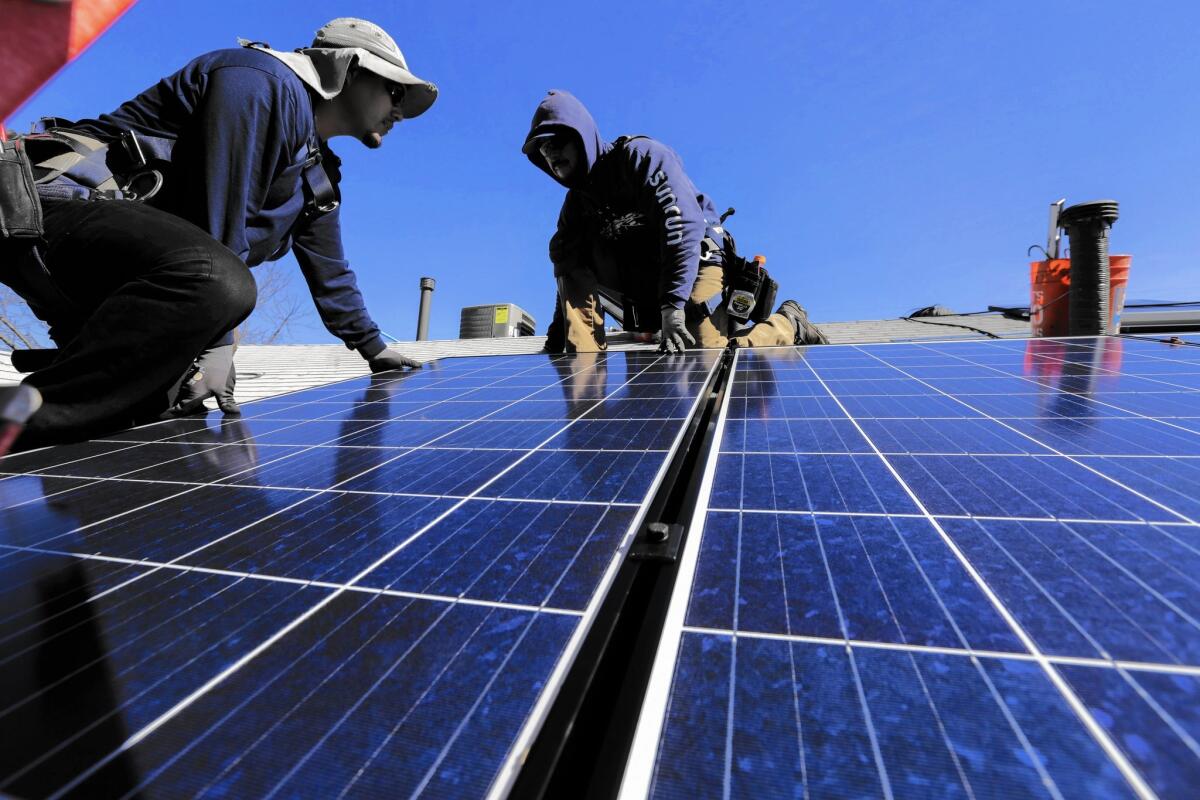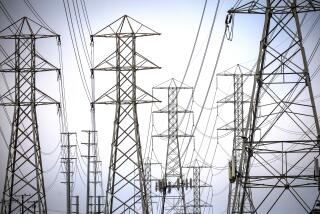How and when to install a rooftop solar system

California regulators have set new rules for compensating rooftop solar owners, so now what?
Do you buy a solar system now or later? Is a lease better than purchasing? How about a loan?
As the pace of purchasing solar power systems picks up, it can get cloudy for consumers who are trying to figure out how and when to enter the market.
See more of our top stories on Facebook >>
As with many rapidly developing technologies, the key is to follow an approach that fits your economic situation, solar experts said. And just because new fees start this year or next, depending on where you live, it’s important to install a system when you are ready, not on some regulatory timetable.
Homeowners who want to go solar can choose from an array of financial options.
“A lot of it is personal customer preference,” said Susan Glick, policy director for Sunrun, the nation’s largest residential solar company. “We do see the majority preferring a solar service, a lease or power purchase agreement. They don’t want to deal with upkeep and maintenance.”
More than a decade ago, it wasn’t clear how significant a player rooftop solar would become. A home with solar panels on the roof seemed trendy, but more the purview of the wealthy.
Utilities complained that those adopting the emerging technology were leaving all the other customers, including low-income ratepayers, to pay for maintenance of the power lines, transformers and substations that made up the electric grid.
California lawmakers and regulators frustrated the utilities with policies that compensated rooftop solar owners for the electricity they generated, a policy called net energy metering. The panel owners were paid on a dollar-for-dollar basis, rather than a lower wholesale price.
The utilities argued that the policy handed a subsidy to wealthy solar owners at the expense of the poor.
But beginning in 2006, a series of advancements from the likes of rooftop solar giant SolarCity and government policy innovator Cisco DeVries gave most homeowners the ability to install solar panels on their houses.
Where homeowners once had to pay tens of thousands of dollars upfront for a solar system, suddenly they could buy, lease, take out a loan or pay the costs through their annual property tax bills.
Each method carries benefits and disadvantages.
Most people, for instance, don’t have the cash sitting in their bank accounts for an average solar system of roughly six kilowatts. That would cost about $14,700 with the benefit of a 30% federal tax credit that runs through 2019, said Jamie Mandel, a principal at Rocky Mountain Institute who focuses emerging technologies, including solar, energy storage, smart controls and microgrids.
The other payment methods carry interest costs on top of the base outlay. Those interest rates can range from 4% to 11%, depending on which financing method consumers choose, Mandel said.
“I think if you’re able to pay for it up front,” Mandel said, “solar is typically a pretty good investment,” allowing a system to pay for itself through energy savings in six or seven years. Savings on a hypothetical $150 monthly power bill would be $47, he said.
Savings decline with the leasing and financing options. Leasing panels results in $30 off the $150 monthly bill, and financing reduces the savings to $22 a month, Mandel said.
Without the upfront cash, prospective solar owners typically need a credit score of at least 650 for programs such as leasing.
Some have criticized the financing and lease programs for making it difficult to sell homes or refinance mortgages.
The Property Assessed Clean Energy financing program, which allows the cost of the solar system to be paid through a homeowner’s property tax bill, has been among the options that have been criticized. With Pace, as it is known, the loan is attached to the property as a tax assessment.
The benefit to home buyers is that the solar system sometimes gets paid off before the sale. The buyer then gets the solar system free and clear.
DeVries, who developed the Pace program, said it took time to resolve some of the challenges to the program, but the success is seen in the milestone reached by its largest user, San Diego-based Renovate America.
As of November, more than $300 million in solar systems had been financed through Renovate America’s use of the Pace program, which it began using in 2011.
“Obviously, there’ve been a number of ups and downs,” said DeVries, president and chief executive of Renewable Funding LLC in Oakland. “The fundamental thing is there.”
Last August, President Obama highlighted Pace financing as an innovative tool to meet the country’s clean-energy and energy-efficiency goals and encouraged its use.
Along with the president’s backing of the program, the Federal Housing Administration, which insures 1 in 5 new mortgages, announced it was developing guidance for the use of Pace financing, which will help overcome lender resistance that has hobbled the program.
Lyndon Rive, SolarCity’s chief executive, said home resales haven’t been an issue for the company, based in San Mateo, Calif., even though 80% of the company’s solar contracts are lease agreements.
Rive’s concern is more about what he predicts will be an erosion of benefits for solar system owners and the electricity they produce.
He anticipates that regulators by 2019 will increase costs to solar providers, who will pass them along to customers. In addition, the 30% federal solar tax credit will end unless Congress renews it.
Last month, the California Public Utilities Commission, by a 3-2 vote, preserved the net-energy metering compensation policy but added fees for new owners that would increase the average solar customer’s monthly bill by about $6 on top of a one-time charge to tie into the grid of $75 to $150 per solar customer.
Current owners don’t have to pay any new fees for 20 years.
Where solar owners might typically save $400 a year on electricity costs now, Rive said, those who install systems after 2019 might see about $250 in savings because of increased demand on solar providers for a wider array of services required by regulators, such as new smart technology.
“In the future, the new rules are going to force the industry to provide more services,” Rive said. “Those services will cost more money. The savings will be less. There will still be a savings and it will still be the right thing to do.”
The solar industry is evaluating changes the California Public Utilities Commission has been implementing in regard to solar. And regulators are still determining the overall impact of integrating rooftop solar into the electric grid.
The grid was designed to distribute electricity to consumers but did not contemplate consumers sending electricity back to the utility companies. That new interaction between the utilities and their customers is forcing changes in how the power companies, consumers and the electric grid function.
A report that Rive and his company released last week said that revamping the electric system with residential solar, energy efficiency and battery storage in mind could save Californians $1.4 billion a year by avoiding costly additions to the electric grid.
The utility industry has taken notice of the impact of the individualized power systems, referring to them as “disruptive technologies.”
DeVries said regulators and the industry should accept the technological shift that is occurring and avoid fighting it.
“They can make it take longer,” DeVries said of the wider adoption of solar and battery storage, “but they cannot stop it.”
Twitter: @ivanlpenn
ALSO
Salinas hopes to turn farm workers’ children into computer scientists
Why it took years for the FDA to warn about infections tied to medical scopes
No Chipotle for lunch today: Its U.S. restaurants shut for a food safety meeting
More to Read
Inside the business of entertainment
The Wide Shot brings you news, analysis and insights on everything from streaming wars to production — and what it all means for the future.
You may occasionally receive promotional content from the Los Angeles Times.











